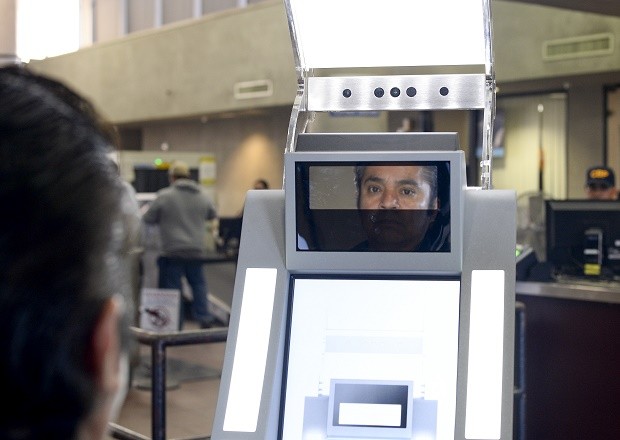
A pedestrian crossing from Mexico into the United States at the Otay Mesa Port of Entry has his facial features and eyes scanned at a biometric kiosk Thursday, Dec. 10, 2015, in San Diego. On Thursday, US Customs and Border Protection began capturing facial and eye scans of foreigners entering the country at San Diego’s Otay Mesa port of entry on foot. AP
SAN DIEGO — The federal government on Thursday began collecting facial and eye scans of foreigners entering the US at a busy border crossing with Mexico, a first step in one of its most ambitious efforts to track people who stay in the country illegally after their visas expire.
Up to half of the people in the US illegally are believed to have overstayed their visas, but the absence of a checkout system has left authorities with no way to identify them.
In a push to change that, Customs and Border Protection began scanning foreigners entering on foot at San Diego’s Otay Mesa port of entry. In February, it will start collecting the same information on foreigners walking into Mexico through the checkpoint.
The trial run, which lasts through June, will help determine if authorities expand screening to foreigners at all land crossings on the 1,954-mile border with Mexico. Authorities will look at the accuracy of the cameras.
Congress has long demanded biometric screening such as fingerprints, facial images or eye scans from people leaving the country, but the task poses enormous financial and logistical challenges, especially at land crossings.
On Thursday, foreigners put their travel documents on a plate at one of the San Diego crossing’s six kiosks and looked into a camera positioned at arms’ length. The process took less than a minute. Then, they walked a few steps to a border inspector for questioning.
“It’s very fast, not inconvenient in the least,” said Rosendo Hernandez of Tijuana, who was on a trip to buy tools.
The government has not announced details on how faces and eyes will be scanned when foreigners leave the country, but an official said most won’t have to stop walking. Scanners will read chip-enabled travel documents at a distance and match the information to entry records.
“It’s basically to verify that the same person that came to the United States is the same person that’s exiting the United States,” said Joe Misenhelter, assistant director at Otay Mesa, the nation’s fourth-busiest port of entry last year.
Starting in February, US citizens heading to Mexico on foot will use a separate lane at the California crossing with scanners that collect biographic information, including name and birth date, but not biometrics, Misenhelter said. They won’t have to stop if their travel documents are chip-enabled.
Marc Rosenblum, deputy director for US immigration policy at the Migration Policy Institute, said the effort aims to fix “the biggest deficiency in the whole system.”
“It’s a huge deal,” Rosenblum said. “What they likely hope is this could be a fast exit check that won’t be terribly expensive or time-consuming to implement.”
Biometric screening has raised objections from privacy advocates who worry authorities may misuse the information or make it vulnerable to identity theft. Jay Stanley, a senior policy analyst at the American Civil Liberties Union, said facial and eye scans may open the door for countries to do the same on American visitors.
Screening also has fueled concerns among businesses and travelers who fear bottlenecks at already congested crossings.
“We have historically controlled our borders coming in but not out,” said Jim Williams, a former Department of Homeland Security official who oversaw efforts to introduce biometric screening at border crossings from 2003 to 2006. “It’s been a lack of infrastructure and lack of investment.”
A 2006 study by the Pew Hispanic Center estimated that between 40 percent and 50 percent of people in the country illegally overstayed their visas — a figure that is generally accepted by immigration experts but notoriously difficult to pin down.
Between 7,000 and 8,000 pedestrians cross at Otay Mesa daily from Tijuana, and slightly less than half of them are US citizens, Misenhelter said. Several had no objections to being scanned.
Marta Alicia Castillo of Ensenada, Mexico, who was headed to a casino, said it was seamless but that Americans should acknowledge that Mexico has the right to demand similar information from visitors if it chooses.
“If you’re visiting a foreign country, they set the rules and you have to obey them,” she said.
RELATED STORIES
Chaos at Hungary border as police tear gas migrants
Brazil auditor worried by border security for Rio Olympics